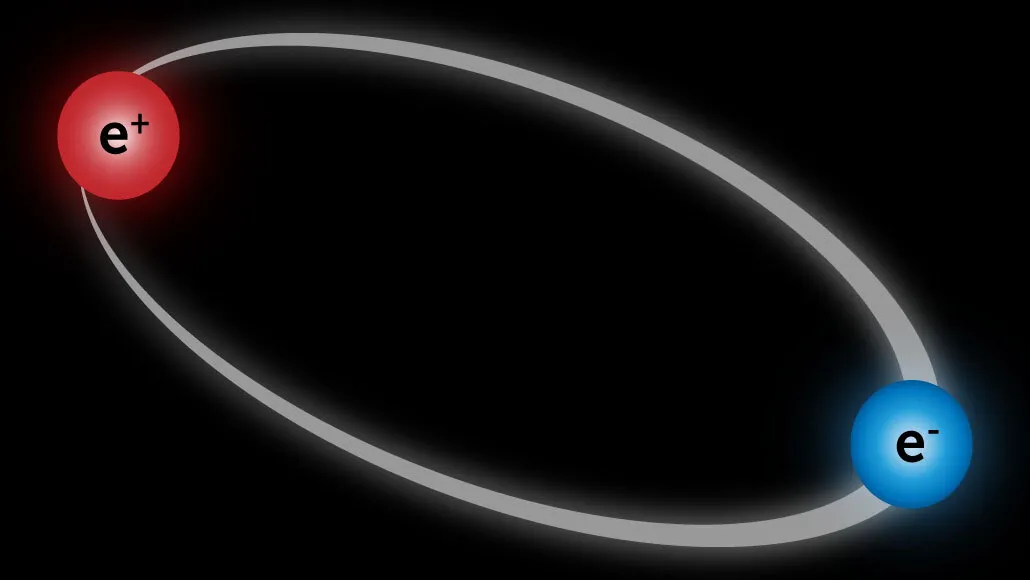A measurement of positronium’s energy levels confounds scientists
The departure from theoretical calculations eludes explanation

A negatively charged electron (blue) and a positively charged positron (red) form positronium. A new study of this exotic variety of atom disagrees with predictions, and scientists don’t understand why.
T. Tibbitts
- More than 2 years ago
Read another version of this article at Science News Explores
Positronium is positively puzzling.
A new measurement of the exotic “atom” — consisting of an electron and its antiparticle, a positron — disagrees with theoretical calculations, scientists report in the Aug. 14 Physical Review Letters. And physicists are at a loss to explain it.
A flaw in either the calculations or the experiment seems unlikely, researchers say. And new phenomena, such as undiscovered particles, also don’t provide an easy answer, adds theoretical physicist Jesús Pérez Ríos of the Fritz Haber Institute of the Max Planck Society in Berlin. “Right now, the best I can tell you is, we don’t know,” says Pérez Ríos, who was not involved with the new research.
Positronium is composed of an electron, with a negative charge, circling in orbit with a positron, with a positive charge — making what’s effectively an atom without a nucleus (SN: 9/12/07). With just two particles and free from the complexities of a nucleus, positronium is appealingly simple. Its simplicity means it can be used to precisely test the theory of quantum electrodynamics, which explains how electrically charged particles interact.
A team of physicists from University College London measured the separation between two specific energy levels of positronium, what’s known as its fine structure. The researchers formed positronium by colliding a beam of positrons with a target, where they met up with electrons. After manipulating the positronium atoms with a laser to put them in the appropriate energy level, the team hit them with microwave radiation to induce some of them to jump to another energy level.
The researchers pinpointed the frequency of radiation needed to make the atoms take the leap, which is equivalent to finding the size of the gap between the energy levels. While the frequency predicted from calculations was about 18,498 megahertz, the researchers measured about 18,501 megahertz, a difference of about 0.02 percent. Given that the estimated experimental error was only about 0.003 percent, that’s a wide gap.
The team searched for experimental issues that could explain the result, but came up empty. Additional experiments are now needed to help investigate the mismatch, says physicist Akira Ishida of the University of Tokyo, who was not involved with the study. “If there is still significant discrepancy after further precise measurements, the situation becomes much more exciting.”
The theoretical prediction also seems solid. In quantum electrodynamics, making predictions involves calculating to a certain level of precision, leaving out terms that are less significant and more difficult to calculate. Those additional terms are expected to be too small to account for the discrepancy. But, “it’s conceivable that you could be surprised,” says theoretical physicist Greg Adkins of Franklin & Marshall College in Lancaster, Pa., also not involved with the research.
If the experiments and the theoretical calculations check out, the discrepancy might be due to a new particle, but that explanation also seems unlikely. A new particle’s effects probably would have shown up in earlier experiments. For example, says Pérez Ríos, positronium’s energy levels could be affected by a hypothetical axion-like particle. That’s a lightweight particle that has the potential to explain dark matter, an invisible type of matter thought to permeate the universe. But if that type of particle was causing this mismatch, researchers would also have seen its effects in measurements of the magnetic properties of the electron and its heavier cousin, the muon.
That leaves scientists still searching for an answer, says physicist David Cassidy, a coauthor of the study. “It’s going to be something surprising. I just don’t know what.”







